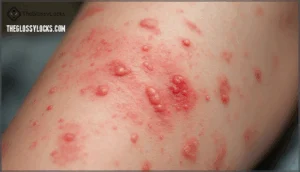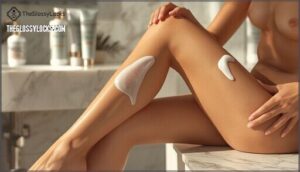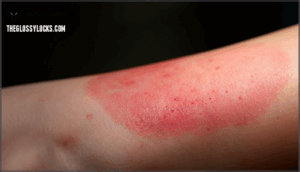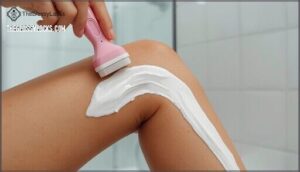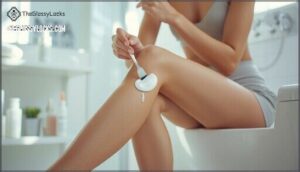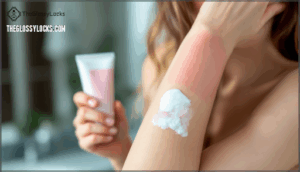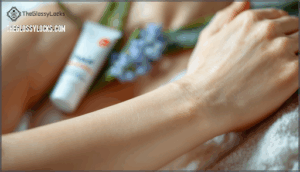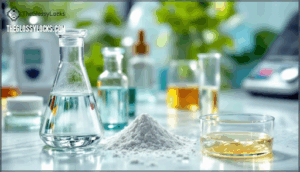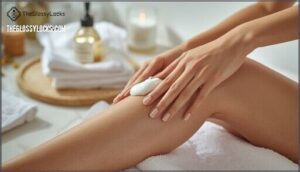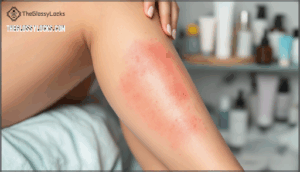This site is supported by our readers. We may earn a commission, at no cost to you, if you purchase through links.

Use Nair too often and you’re practically asking for chemical burns, inflammation, and an angry skin barrier that takes weeks to recover. The safe window? Every three to four days minimum, with a full 72 hours between applications whenever possible. Your skin needs that time to repair and rebuild its defenses.
Get the timing right, and you’ll stay smooth without the painful consequences.
Table Of Contents
- Key Takeaways
- How Often Can You Use Nair?
- What Happens if You Use Nair Too Often?
- How Long Do Nair Results Last?
- Can You Use Nair Twice in One Day?
- Safe Application Tips for Nair
- Precautions for Sensitive Skin Types
- Nair Ingredients and Skin Safety
- Aftercare Following Nair Use
- When to Avoid or Discontinue Nair
- Frequently Asked Questions (FAQs)
- Conclusion
Key Takeaways
- Wait at least 72 hours between Nair applications on the same area because your skin needs time to repair its protective barrier after exposure to the corrosive chemicals that break down hair.
- Using Nair too frequently increases your risk of chemical burns, inflammation, allergic reactions, and skin damage since repeated applications prevent proper recovery and can cause up to 25% greater absorption of harmful ingredients.
- Results from Nair typically last between two days and one week depending on your hair growth rate, skin type, and the specific product formula you use.
- Always patch test before each application, avoid using Nair on broken or irritated skin, and discontinue use immediately if you experience persistent redness, burning, blistering, or rashes that signal your skin can’t tolerate the product.
How Often Can You Use Nair?
Nair hair removal cream can be a convenient option for keeping skin smooth between showers. But like any chemical product, your skin needs time to recover between applications.
Let’s look at how often you can safely use Nair and what factors should guide your routine.
Recommended Usage Frequency
Most people can use Nair safely every three to four days, giving your skin time to recover between applications. This recommended usage frequency follows product guidelines designed to minimize irritation while maintaining effectiveness. Your skin needs this recovery window because Nair contains strong chemicals that temporarily break down hair structure. Skipping proper intervals increases your risk of chemical burns and other reactions.
Nair product usage guidelines recommend:
- Wait at least 72 hours between applications on the same area for skin recovery that’s best
- Perform patch testing before each use to monitor for new sensitivities or allergic reactions
- Follow manufacturer instructions precisely to make certain of long-term safety and product effectiveness
- Space applications based on your individual hair growth rate and skin sensitivity level
Understanding these usage guidelines protects your skin while delivering consistent results from your Nair hair removal products.
Minimum Time Between Applications
The hard truth is that your skin needs a real break between applications—at least 72 hours, which means waiting three full days before treating the same area again. This reapplication safety window isn’t arbitrary. Your skin recovers from the chemical depilation process during this time.
Skipping it dramatically increases irritation prevention failure and raises your risk of chemical burns or rashes. Patch test frequency matters too. Test before each use to monitor individual tolerance, especially if you’re pushing closer to that three-day mark. Your skin’s reapplication safety depends on respecting these intervals.
Factors Affecting Usage Intervals
Your skin’s tolerance depends on several factors beyond that three-day minimum. Where you apply Nair matters—facial skin needs one to two weeks between uses because it’s thinner. Body areas like legs recover faster.
Your skin type, hydration level, and hormonal changes all influence how quickly you can safely reapply. Product formulation varies too. Sensitive-skin versions with aloe allow shorter intervals than standard formulas. If you have eczema or psoriasis, you’ll need longer breaks.
The active ingredients in Nair, such as thioglycolic acid salts, break down the hair.
What Happens if You Use Nair Too Often?
Using Nair too often puts your skin at risk. Your skin needs time to recover between applications, and ignoring that timeline can lead to uncomfortable reactions.
Let’s look at what happens when you overuse this product.
Risks of Overuse
Using Nair too often puts your skin at serious risk. When you exceed the recommended frequency—more than once every 72 hours—you’re exposing your skin to repeated chemical assault. The active ingredients like potassium thioglycolate are classified as corrosive irritants capable of causing dermal burns.
Overuse breaks down your skin’s protective barrier, increases inflammation, and raises your risk of allergic sensitization. Studies show that chronic application produces sustained immune activation and cellular injury.
You’re also raising systemic toxicity concerns as your skin’s absorption potential increases by up to 25% with repeated damage. Your skin needs recovery time between applications—that’s not optional, it’s biology.
Consider using electric trimmers instead for a safer alternative.
Potential Skin Reactions
Your skin can react in different ways depending on how often you use Nair and how sensitive you are to its active ingredients. Overusing Nair damages your skin’s protective barrier and increases your risk of adverse reactions:
- Chemical Burns – Potassium thioglycolate and sodium hydroxide are corrosive. Frequent applications can cause blistering, peeling, and painful burns that resemble heat damage.
- Allergic Responses – Repeated exposure sensitizes your immune system. You may develop rashes, hives, or severe inflammation even if you tolerated Nair before.
- Irritation Symptoms – Redness, burning sensations, and swelling occur when your skin can’t recover between applications. Patch testing before each use helps catch emerging sensitivity early.
Stop using Nair immediately if you experience severe reactions and consult a dermatologist.
Signs of Irritation to Watch For
It’s easy to miss the early warning signs that your skin is struggling to tolerate Nair’s potent chemicals. Pay close attention to what happens in the hours after application. Mild redness is normal, but spreading redness, intensifying heat, or persistent flushing signals a problem. Itching or burning sensations that worsen instead of fade mean your skin is reacting negatively. Watch for small bumps, hives, or a rash resembling an allergic reaction.
| Symptom | Severity | Action |
|---|---|---|
| Mild redness that fades | Low | Continue monitoring |
| Spreading redness or heat | Moderate | Rinse and stop use |
| Itching or burning | Moderate | Discontinue immediately |
| Blisters or peeling | Severe | Seek dermatologist |
Blistering, oozing, or excessive peeling indicates chemical burns. Swelling around treated areas or facial edema suggests an allergic reaction requiring immediate attention. Rinse thoroughly with cool water, apply gentle moisturizer, and avoid sun exposure. Don’t reapply until fully healed. Contact your dermatologist if symptoms persist beyond one to two days or if you develop respiratory symptoms like wheezing. Your skin sensitivity can change over time, which is why patch testing before each use matters.
How Long Do Nair Results Last?
The results you get from Nair don’t stick around forever. Your skin will stay smooth for a little while, but eventually your hair will grow back and you’ll need to treat the area again.
Let’s look at how long you can expect those results to last and what affects how quickly your hair returns.
Typical Duration of Smoothness
Nair results generally last between two days and one week, depending on how fast your hair grows back. Your hair growth rate, skin type, and the specific product formula you choose all play a role in how long you stay smooth. Lifestyle factors like friction from clothing or activities that cause sweating can also speed up regrowth.
Individual variations mean what works for your friend mightn’t match your timeline. That’s why paying attention to your own patterns helps you plan treatments effectively.
Hair Regrowth Timelines
Hair regrowth begins within a few days to two weeks after Nair use, varying by location and hair thickness. Leg hair usually becomes visible within one to two weeks, while facial hair regrows in roughly two weeks. Thicker hair on areas like the bikini line regrows slower than finer facial hair.
Your hair follicles enter the anagen phase, stimulating growth activity. Unlike shaving, which shows regrowth in one to two days, Nair keeps skin smooth for days to weeks.
Influencing Factors on Results
What you’re seeing on your skin isn’t just about the product itself—your genetics, hormones, and even where you’re using Nair all play a role in how long those smooth results actually stick around. Hair growth rates vary considerably based on your body chemistry and skin type. Finer facial hair may regrow faster than coarser leg hair on the same person.
Your application method matters too. A thick, even layer removes hair closer to the skin than a thin one, extending smoothness. Product choice and skin sensitivity also influence results and how often you can safely repeat applications without triggering irritation.
Can You Use Nair Twice in One Day?
Using Nair twice in one day isn’t recommended, and there are good reasons why. Your skin needs time to recover between applications.
Let’s look at what the manufacturer says, how your skin actually bounces back, and what you can do if you miss some spots the first time around.
Manufacturer Guidelines
The manufacturer recommends waiting at least 72 hours between applications to give your skin time to recover. Here’s what you need to know:
- Follow product warnings — Nair’s label clearly states the 72-hour minimum to prevent chemical burns and rashes.
- Application frequency matters — Using Nair more often increases your risk of skin irritation and allergic reactions.
- Patch testing before each use — This helps you monitor for new sensitivities, especially with frequent application.
- Usage intervals affect safety — Spacing applications properly reduces irritation likelihood and keeps your skin barrier intact.
Skipping these guidelines puts your skin at real risk.
Skin Recovery Considerations
Your skin needs time to bounce back after Nair does its work, and understanding why matters for keeping irritation at bay.
When you apply Nair, its product ingredients break down hair while also stripping away dead skin cells. This chemical process stresses your skin barrier. Your skin needs at least 72 hours to repair and rebuild its protective layer. Using Nair twice in one day prevents this recovery, increasing irritation prevention failures and hydration loss.
Sun sensitivity peaks after application, making exfoliation timing critical—wait several days before exfoliating. If you rush applications, you risk cumulative side effects like chemical burns or rashes. Dermatologists recommend respecting this recovery window to avoid serious skin reactions.
Alternative Solutions for Missed Spots
If you missed a spot during application, resist the urge to slap on more Nair right away—there are smarter ways to address it. Tweezing missed hairs is your safest immediate option. Wait at least 72 hours before reapplying Nair to the same area.
For spot treatment, consider alternative hair removal methods like razors or professional hair removal services. These options let your skin recover while addressing stray hairs effectively, avoiding cumulative skin irritation and potential Nair side effects from rushed reapplication.
Safe Application Tips for Nair
Getting the best results from Nair means applying it the right way. How you layer the product, when you apply it, and knowing which areas to skip can make a real difference in avoiding irritation and achieving smooth skin.
Here’s what you need to know to use Nair safely and effectively.
Proper Layering Techniques
Getting the thickness right matters more than you might think—apply Nair in a layer that completely covers your hair without gaps, but don’t slather it on so much that it drips or wastes product. Think of it like frosting a cake: enough to do the job, not so much it runs off the edges.
Proper layering makes certain the active ingredients in Nair work effectively. Here’s what you need to know:
- Use an applicator tool for even coverage and to avoid rubbing, which can irritate your skin and reduce how well the product works
- Check for complete coverage by looking at the area from different angles; missed spots mean incomplete hair removal
- Aim for a consistent thickness that lets you see your skin slightly beneath the layer—this is the ideal balance for chemical depilatory usage
The layering benefits go beyond just better results. Even coverage means your skin gets exposed to the active ingredients uniformly, reducing the risk of patchy irritation or missed hairs. When you apply Nair correctly, you’re giving it the best chance to break down those keratin bonds without overdoing it on any one spot.
Application Timing and Removal
Once you’ve applied that perfect layer, timing is everything—most Nair products work best when you leave them on for 3 to 10 minutes, though your specific formula may vary. Set a timer to avoid guessing.
Remove Nair gently with a damp washcloth or the included scraper. Don’t scrub hard; let the tool do the work. Rinse thoroughly in the shower afterward to clear residue and give your skin a fresh start.
Here’s what to keep in mind:
| Application Duration | Key Consideration |
|---|---|
| Too short (under 3 min) | Hair may not fully remove; incomplete results |
| Best (3–10 min) | Best balance for effectiveness and safety |
| Too long (over 15 min) | Increased irritation and chemical burns risk |
| Shower Cream timing | Apply during shower; follow product directions |
| Pre-bed application | Avoid; skin needs hours to breathe after removal |
Avoid applying Nair right before bed or under tight clothing. Your skin needs airflow to recover. Water temperature matters too—use lukewarm water for rinsing, never hot, since heat increases irritation. This timing and removal approach minimizes hair removal side effects while maximizing product effectiveness and safety.
Areas to Avoid
Not every patch of skin on your body is safe for Nair, and knowing which areas to avoid can save you from unnecessary irritation or harm. Skip your nose, ears, eyes, and eyebrows entirely—these sensitive zones can’t tolerate depilatory chemicals. Avoid damaged skin, open cuts, or irritated areas too.
Stick to using facial or mild formulas on your face. If you’re uncertain whether a spot is safe, test a small hidden area first or ask your dermatologist before applying.
Precautions for Sensitive Skin Types
If you have sensitive skin, you might worry that Nair isn’t an option for you. The good news is that Nair offers formulas designed specifically for gentler treatment.
However, your skin’s sensitivity can change over time, so it’s important to know how to protect yourself and adapt your routine accordingly.
Choosing Sensitive Formulas
Sensitive formulas exist because standard Nair products can be too strong for certain skin types. When you have reactive or delicate skin, using a regular depilatory cream feels like bringing a sledgehammer to a job that needs a scalpel. Nair offers gentler versions specifically designed to minimize irritation while still removing hair effectively. These formulas use the same chemical process but with reduced concentrations of active ingredients like calcium or potassium thioglycolate, making them less likely to trigger the burning, redness, or rash that can plague sensitive users.
The choice matters because your skin’s tolerance to Nair can vary. What works fine one month might cause problems the next as your body chemistry shifts. Starting with a sensitive formula gives you a safer entry point, especially if you’re new to depilatory creams or have a history of skin reactions. You can always patch test a regular formula later if you find the gentle version works well for you.
Look for mild ingredients like aloe or chamomile in gentle Nair formulations. These additions soothe skin during the hair removal process. Before committing to full application, always do a patch test on a small area. Compare formulas by reading labels carefully. This approach prevents irritation and helps you avoid unnecessary discomfort. Choosing the right formula is your first line of defense against adverse reactions.
Managing Skin Sensitivity Changes
Body chemistry shifts constantly, which means your skin’s tolerance to Nair can change unexpectedly. What worked perfectly last month might trigger irritation today. That’s why patch testing before each application remains essential—not just the first time, but every time you use it.
Gradual introduction of any formula change gives your skin time to adapt. Prioritize hydration importance through moisturizing after removal.
If you notice new skin reactions or allergic reactions developing, switch formulas or take a break. Monitor closely for signs of skin irritation and infections, then consult a dermatologist if problems persist.
Nair Ingredients and Skin Safety
Understanding what’s actually in Nair and how it affects your skin is key to using it safely. The chemicals that make Nair work are powerful, which is why they’re so effective but also why your skin needs time to recover between uses.
Let’s break down the ingredients and how they interact with your body so you can make informed choices about whether Nair is right for you.
Key Active Ingredients Explained
Nair’s magic lies in thioglycolate—either calcium or potassium versions—which breaks apart the sulfur bonds holding your hair together. To work properly, these active ingredients need an alkaline environment, so Nair includes pH adjusters like calcium hydroxide or sodium hydroxide, raising the mixture to around 12 to 12.5. That’s why it works, though it can sting.
To counteract dryness and irritation, emollients like mineral oil and urea help restore moisture. Fragrance masks the sulfur smell from the chemical reaction, while botanical extracts like green tea offer soothing benefits in sensitive formulas.
How Nair Works on Hair and Skin
Here’s what actually happens when Nair meets your hair and skin surface.
Nair works two ways. The thioglycolate chemicals break sulfur bonds in your hair’s keratin structure, dissolving it rather than pulling from the root. Simultaneously, Nair exfoliates dead skin cells, creating that smooth feeling. You’ll apply a thick layer and wait—usually 3 to 10 minutes—without rubbing, since friction interferes with the chemical reaction. The alkaline environment activates keratin breakdown but also explains the stinging sensation. Since hair removal happens only at the surface level, results last 2 days to a week depending on your individual growth rate.
What this means for you:
- Your skin feels the intensity of strong chemicals designed to dissolve hair fibers
- Results fade faster than waxing since the hair root remains untouched
- Timing matters—letting chemistry work without interference prevents irritation
- Each person’s results vary based on their unique hair growth cycle
- Understanding this process helps you use Nair safely and effectively
Common Allergens and Irritants
Since Nair’s chemicals can trigger reactions in ways you mightn’t expect, understanding what’s actually in the product helps you protect your skin before problems start. The main culprits are thioglycolates and hydroxides—they’re what dissolve hair but can also irritate sensitive skin. Some people develop allergic reactions to these ingredients, while others experience chemical burns or rashes from overuse.
That’s why patch testing matters. Apply a small amount to your inner arm 24 hours before full application. Watch for redness, itching, or burning. If your skin reacts, Nair isn’t your solution.
Body chemistry changes too—what worked last year might irritate you now. When in doubt, choose gentler formulas designed for sensitive skin, and stop immediately if problems develop.
Aftercare Following Nair Use
Your skin needs care after using Nair to stay healthy and comfortable. The chemicals in the product do their job breaking down hair, but they also leave your skin temporarily sensitive and vulnerable.
Here’s what you should know to protect and soothe your skin after treatment.
Soothing and Moisturizing Skin
After using Nair, your skin needs some TLC to bounce back and stay comfortable. Apply a fragrance-free moisturizer within minutes to support barrier repair and post-Nair hydration. Choose gentle ingredients like aloe or ceramides to calm irritation. Here’s what dermatologists recommend:
- Moisturize immediately after showering to lock in hydration and prevent dryness
- Use fragrance-free products to avoid additional irritation to sensitized skin
- Skip active ingredients like retinoids for 48 hours to allow skin recovery
Long-term care matters too. Avoid harsh soaps and exfoliants for several days. If sensitivity persists, consult a dermatologist about underlying skin conditions.
Sun Exposure Precautions
Your skin’s already been through something after Nair, so protecting it from the sun is the next smart move. Nair can increase UV sensitivity and photosensitivity risks for several days. Avoid direct sun exposure and tanning beds for at least 48 hours post-application. Apply broad-spectrum sunscreen (SPF 30+) daily if you must go outside. Sunburnt skin after Nair use signals serious irritation—consult a dermatologist if this occurs.
| Timeline | UV Risk Level | Sun Protection Needed | Action |
|---|---|---|---|
| First 24 hours | Very High | Stay indoors or cover skin | Avoid all sun exposure |
| 24-48 hours | High | SPF 30+ sunscreen required | Limit outdoor time |
| 48-72 hours | Moderate | Continue sunscreen daily | Monitor for reactions |
| Beyond 72 hours | Normal | Regular sunscreen routine | Skin fully recovered |
Signs You Need a Break Between Uses
Watch for these warning signs that your skin needs recovery time. Redness, itching, or burning sensations mean stop using Nair immediately. Peeling skin or developing rashes signal irritation—don’t apply more product.
If side effects persist beyond a few hours, consult a dermatologist about skin sensitivity and alternative options. These reactions aren’t unusual, but they’re your skin’s way of telling you it needs a break. Respect that message.
When to Avoid or Discontinue Nair
Nair works well for most people, but it’s not right for everyone. Some folks experience allergic reactions or find their skin simply can’t tolerate it.
Knowing when to stop using Nair and what to do instead matters just as much as knowing how to use it safely.
Contraindications and Allergic Reactions
Certain conditions make Nair unsafe for you. Avoid it if you have broken, inflamed, or sunburned skin, as chemical burns may develop. Known allergies to thioglycolate or calcium hydroxide require complete avoidance. Pre-existing skin disorders like eczema or psoriasis increase your risk of severe reactions.
About 6% of users develop allergic reactions, including redness, itching, or blistering within 24 hours. Fragranced formulas pose risks for 15–20% of people with fragrance sensitivity.
If you experience Nair safety questions or skin reactions to Nair, stop use immediately and rinse thoroughly with cool water.
When to Consult a Dermatologist
When symptoms persist or reactions don’t improve after stopping use, it’s time to reach out to a dermatologist. Seek professional guidance if you experience severe reactions like chemical burns, blistering, or scarring concerns. Persistent irritation lasting beyond a few days also warrants evaluation.
A dermatologist can assess your skin sensitivity and irritation patterns, rule out allergies, and recommend safer alternative options suited to your needs. Don’t wait—early consultation prevents complications and helps you find effective hair removal methods that work for your skin.
Alternative Hair Removal Options
If Nair isn’t working out for your skin, you’ve got other options that might be a better fit. Waxing removes hair from the root and lasts longer—usually a couple weeks. Shaving is quick but results fade fast. Laser hair removal targets follicles for lasting smoothness over multiple sessions. Threading works well for facial hair and small areas. Electrolysis permanently removes individual hairs. Epilation devices pluck multiple hairs at once.
Talk with a dermatologist about which method suits your skin best.
Frequently Asked Questions (FAQs)
What types of areas can I use Nair on?
Nair works on legs, arms, and underarms with excellent results. You can apply it to your bikini area using the appropriate formula.
Facial Nair targets upper lip and chin hair safely. Avoid sensitive zones like eyebrows, nose, ears, and eyes.
Always patch test first on any new area.
Is Nair suitable for sensitive skin?
Nair isn’t a one-hair-fits-all solution for sensitive skin, but it doesn’t have to be off-limits either. Sensitive formulas exist specifically for gentler treatment.
Before using any Nair product, patch test first to check for skin reactions. Body chemistry varies, so mild irritation might occur even with sensitive options.
If you experience redness or burning, discontinue use and consult a dermatologist for alternative hair removal methods.
Can I use Nair on my face?
Yes, you can use Nair on your face, but only with facial formulas designed for delicate facial skin. These mild formulas, like Nair Face Cream Hair Remover, work gently on sensitive areas.
Always patch test first before applying chemical depilatories to your face.
Is Nair safe to use on bikini or intimate areas?
Nair offers specialized formulas like Nair Bikini Cream designed for bikini area safety, but intimate skin sensitivity requires caution.
These formulas address pubic hair removal with gentler ingredients, reducing Nair burn risks.
Always patch test safe application zones before use, and avoid applying directly to genitals or mucous membranes.
Can you use Nair on your face and how often?
Facial Nair safety requires using only mild formulas designed specifically for the face.
Apply these products no more than every 72 hours to prevent skin sensitivity and irritation.
Always do a patch test first.
Does Nair work on all hair types and colors?
Chemical depilatories like Nair work universally on hair structure regardless of color or type. The product breaks down keratin fibers in all hair, though thick or coarse hair may need longer application times for complete removal.
Whats the difference between Nair and waxing results?
Results reveal a real difference: waxing removes hair from the root, extending smoothness up to six weeks, while Nair dissolves hair at the surface for regrowth within days.
Waxing hurts more but costs more too.
Conclusion
What’s the point of smooth skin if it comes with chemical burns and weeks of recovery? Knowing how often you can use Nair isn’t just about convenience—it’s about protecting your largest organ from unnecessary damage.
Stick to the three-to-four-day rule, listen when your skin protests, and don’t push through warning signs for the sake of smoothness. Your skin has a memory, and overuse leaves lasting marks.
Treat it with the respect it deserves, and you’ll get the results you want without the regret.
- https://hair-everyday.com/blogs/hair-care/how-often-can-you-use-nair
- https://www.getlabtest.com/news/post/how-does-nair-work-guide
- https://www.brio4life.com/blogs/mens-grooming/is-nair-bad-for-you
- https://medisearch.io/blog/does-nair-cause-cancer
- https://www.myhsteam.com/resources/can-you-use-hair-removal-cream-with-hs

